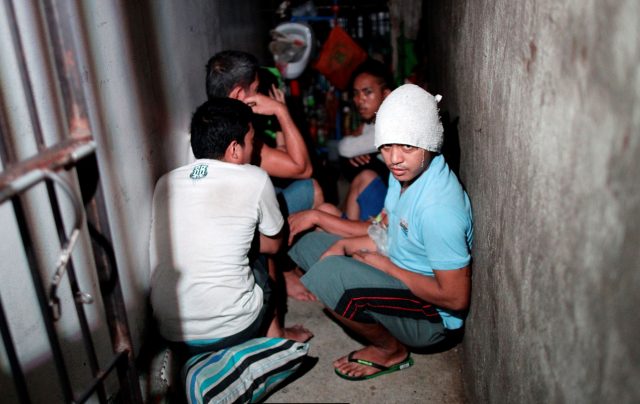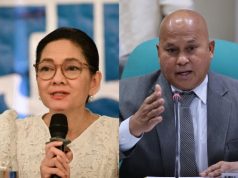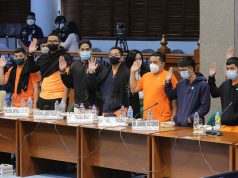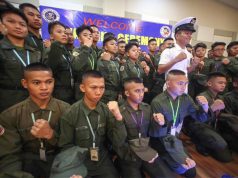(Updated 11:42 p.m.) Filipino international documentary photographer Ezra Acayan on Sunday shared the horrifying story behind the “secret cell” of illegally detained Filipinos during the bloody drug war which was featured in the award-winning documentary “Aswang.”
In the full-length movie “Aswang,” Filipino filmmaker Alyx Ayn Arumpac recounts the first two years of the Duterte administration’s bloody drug war which has killed thousands of Filipinos, particularly women and children from the urban poor.
The campaign called “Oplan Tokhang” was spearheaded by the Philippine National Police under the leadership of neophyte senator Roland “Bato” Dela Rosa.
The film was released online via selected streaming platforms on Saturday, July 11. It was supposed to be part of the Daang Dokyu Festival scheduled last March.
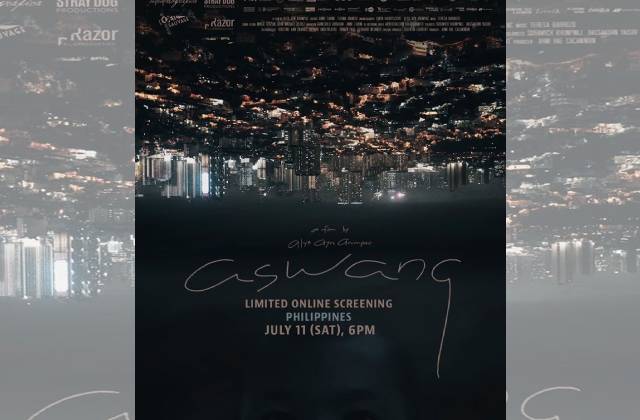
Following its online release, the word “aswang,” and the hashtag #AswangMovie immediately trended on social media over the weekend.
Among the events which made a buzz online was the tale of the secret prison located behind a bookshelf in a police station in Tondo, Manila, which also made headlines in prestigious news organizations in 2017.
The “Aswang” documentary was a recipient of the Amnesty International Award at the Thessaloniki Documentary Festival 2020 and the FIPRESCI Award at the International Documentary Film Festival in Amsterdam in 2019.
What happened during the coverage in 2017?
In a thread he shared on Twitter on July 12, award-winning photojournalist Acayan recalled that his colleagues were initially not provided details of their coverage even during the travel toward the police station.
Acayan also attached some photos he took during the coverage.
“Everyone readied their cameras and got into the cars. I was driving one of the vehicles. The convoy was led by a van that had lawyers from CHR. We followed them, clueless as to where we were headed,” he said.
We had no idea at all.
A day before we were just told to meet up at a specified place and time. We were not advised at all what we were gonna cover. They just told us that it was really important and that we should come. (thread) pic.twitter.com/YOYfDDX08i
— Ezra Acayan (@eacayan) July 12, 2020
Acayan shared that when they arrived at MPD Station 1 or Presinto Uno, after the lawyers interrogated the police officers, he and his colleagues followed them toward the back entrance where they saw people lined up and then proceeded toward the station’s drug enforcement unit’s office.
The office was also filled with more people, the photographer recalled. However, what surprised them was when a man knocked at an unsuspecting bookshelf and then someone responded.
“Amid the commotion, the man in the turquoise shirt approached a bookshelf and began knocking at it and shouted “may tao ba diyan sa loob?!” A voice inside the wall responded ‘may tao po!’ It was only then when we finally realized what was happening,” Acayan said.
“The next thirty seconds would be one of the most unforgettable moments of my life. The man in the turquoise shirt slid the bookshelf open like a door. People emerged from inside with their hands raised. We couldn’t believe what we were seeing, it was a hidden jail cell,” he added.
Acayan recounted that twelve people were detained inside the tiny room without windows, light and ventilation for a week apparently beaten and tortured. No charges were filed against them.
What CHR did
However, he said the most terrifying part was the reaction of personnel from the Commission of Human Rights. This incident was also revealed in “Aswang.”
“The entire thing was reduced to a photo op. I could remember that night, me and my colleagues were disappointed to hear the other CHR people murmur to themselves, that they couldn’t spend any time longer there as they had a dinner event to catch,
Acayan said.
Such a story which was also picked up by the Washington Post and BBC and covered by news wires such as Reuters became one of the highlights of the alleged human rights violations during President Rodrigo Duterte’s presidency.
The police responsible for keeping these detainees locked up without charges had been accused of using them for extortion.
However, despite the public outcry against the PNP, Dela Rosa still defended his subordinates’ actions at that time.
The CHR for its part clarified that its made moves to hold the authorities involved in the anomalous “secret cell” accountable by filing a case against them before the Office of the Ombudsman. The case was filed May 11, 2017 led by Commissioner Karen Gomez Dumpit.
“Lumahok din ang CHR sa isinagawang inquiry ng Committee on Human Rights ng House of Representatives ukol sa secret jail para ilahad ang aming mga natuklasan sa noong kalakaran sa MPD Station 1,” CHR spokesperson Jacqueline Ann De Guia said in a statement.
BASAHIN: Pahayag ni Atty Jacqueline Ann de Guia, CHR Spokesperson, kaugnay ng naging aksyon ng CHR sa Tondo secret jail#AswangMovie #RaxabagoSecretJail pic.twitter.com/jO6J9LlsLq
— CHR Philippines (@chrgovph) July 13, 2020
Other musings for ‘Aswang’
Meanwhile, the documentary Aswang received praises on local Twitter.
Rep. Sarah Elago (Kabataan Party-list) encouraged her followers to watch the documentary and even shared promo codes to them to use for Vimeo, a video streaming platform.
New promo codes!https://t.co/Imvc7ke2ZG
CODE:ASWANGFOURhttps://t.co/IUMuVzLzZf
CODE:ASWANG5IVEhttps://t.co/Wxma5SL2Im
CODE:ASWANGSIX
From #AswangMovie FB Page— Sarah Elago (@sarahelago) July 12, 2020
Twitter user @KebinEleben, meanwhile, shared screenshots of his favorite parts of the movie.
I got no words to say. #Aswang #AswangMovie pic.twitter.com/fAnr63K2Ft
— k e b e n (@KebinEleben) July 11, 2020
Karapatan researcher Philip Jamilla also shared screenshots of impactful scenes and expressed hope that viewers would feel unsettled enough to demand justice for the victims.
As you watch #AswangMovie, allow yourself to feel uncomfortable and unsettled. Allow yourself to be restless and sleepless tonight. Allow yourself to feel their grief, their pain, their despair, their rage—but never fear. Allow yourself to feel anger, to demand justice, to fight. pic.twitter.com/mQaSUBQKAT
— Philip Jamilla (@pmjamilla) July 11, 2020
Another user shared that after watching the film, Filipinos can describe the mythical creature “aswang” as “shape-shifting humans of authority.”
no longer is the aswang a mere filipino folktale about shape-shifting humans who instill fear by killing. aswang is a new terminology for shape-shifting humans of authority with blood-stained hands in blue uniforms.
— 𝖘 (@scheblit) July 12, 2020

